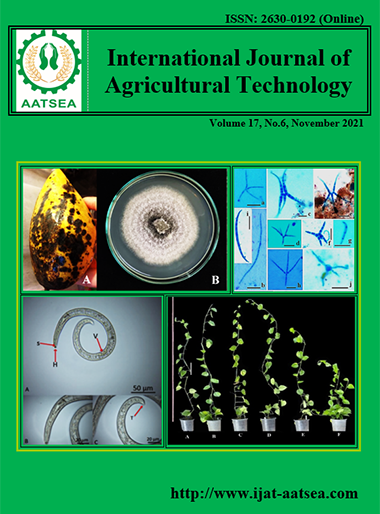The Diversity of Terrestrial Earthworm in Agricultural Land and Adjacent areas, Uttaradit Province, Thailand
Main Article Content
Abstract
The diversity of terrestrial earthworms was studied in 4 sub-districts of Uttaradit Province namely; Numrid, Kungtapao, Pasao, and Hadkruad. The earthworms and soil samples were collected in 6 land types consisted of rice field, vegetable plantation, Crop plantation, Orchard, Grove, and Residential area. Results showed that 24 earthworm species in 5 families were founded. Pontoscolex corethrurus was the only one of the family GLOSSOSCOLECIDAE. We founded 15 species of the family MEGASCOLECIDAE, 3 species of the family MONILIGASTRIDAE, 4 species of the family OCTOCHAETIDAE, and 1 species of ALMIDAE. Of these, 10 were supposed to be new species. The most diversity of earthworm species was found in the Pasao sub-district (21 species). The highly abundant species were M. posthuma, M. peguana, and M. houlleti respectively. The population density of earthworms was significantly different in June and August; highly in vegetable plantation areas followed by residential areas respectively
Article Details

This work is licensed under a Creative Commons Attribution-NonCommercial-NoDerivatives 4.0 International License.
References
Buurman, P., Van, B. and Velthorst, E. J. (1996). Manual for Soil and Water Analysis. Leiden: Backhuy.
Edwards, C. A. (2004). Earthworm Ecology. 2nd ed., Florida: CRC Press.
Edwards, C. A. and Bohlen, P. J. (1996). Biology and Ecology of Earthworms.3rd ed. London: Chapman and Hall.
Gates, G. E. (1972). Burmese Earthworms : an introduction to the systematics and biology of Megadrile oligochaetes with special reference to Southeast Asia. Transactions of the American Philosophical Society, 62:1-326.
Gerard, B. M. (1967). Factor affecting earthworm in pastures. Animal Ecology, 36:235-252.
Johnston, A. S. A., Richard, M. S., Mark, E. H., Tania, A. and Pernille, T., (2015). Effects of agricultural management practices on earthworm populations and crop yield: validation and application of a mechanistic modelling approach. Journal of Applied Ecology, 52:1334-1342.
Krebs, C. J. (1985). Ecology: The Experimental Analysis of Distribution and Abundance. New York: Harper and Row.
Lavelle, P., Brussaard, L. and Hendrix, P. (1999). Earthworm Management in Tropical Agroecosystems. New York: CABI Publishing. p:27-55.
Lavelle, P., Decaëns, T., Aubert, M., Barot, S., Blouin, M., Bureau, F., Margerie, P., Mora, P. and Rossi, J. P. (2006). Soil invertebrates and ecosystem service. European Journal of Soil Biology, 42:3-15.
Marhan, S. and Scheu, S. (2005). The influence of mineral and organic fertilizers on growth of the endogeic earthworm Octolasion tyrteaum (Savigny). Pedobiologia, 49:239.
Mulia, R., Hoang, S. V., Dinh, V. M., Duong, N. B. T., Nguyen, A. D., Lam, D. H., Thi Hoang, D. T. and Noordwijk, M. (2021). Earthworm Diversity, Forest Conversion and Agroforestry in Quang Nam Province, Vietnam. Land, 10:36.
Nunes, D. H., Pasini, A., Benito, N. P., and Brown, G. G., (2006). Earthworm Diversity in Four Land Use Systems in the Region of Jaguapitã, Paraná State, Brazil. Caribbean Journal of Science, 42 (3): 331-338.
Phillips, H. R. P. (2019) Global distribution of earthworm diversity. Science, 366:480-485.
Prasuk, K. (2005). Species diversity of terrestrial earthworms in Khao Yai national park. (Doctor Thesis). Suranaree University of Technology, Thailand.
Richard, G. S., Claire, P. M., Grandy, A. S., Suwanwaree, P., Renate, M. S. and Robertson, G. P. (2008). Diversity and abundance of earthworms across an agricultural land-use intensity gradient. Soil & Tillage Research, 100:83-88.
Sims, R. W. and Easton, E. G. (1972). A numerical revision of the earthworm genus Pheretima (Megascolecidae: Oligochaeta) with the recognition of new genera and an appendix on the earthworms collected by the royal society North Borneo Expedition. Biological Journal of the Liennean Society, 4:169-268.
Somniyam, P. and Suwanwaree, P. (2009). The Diversity and Distribution of Terrestrial Earthworms In Sakaerat Environmental Research Station and Adjacent Areas, Nakhon Ratchasima, Thailand. World Applied Sciences Journal, 6:221-226.
Somniyam, P. and Phatdiphanpreeda, P. (2016). The diversity of terrestrial earthworms in Phusoidao National Park and adjacent area, Thailand. International Conference on Science and Technology. Uttaradit Rajabhat University, Uttaradit, Thailand, 147 p.
Singh, J. (2018). Role of Earthworm in Sustainable Agriculture. Sustainable Food Systems from Agriculture to Industry: Improving Production and Processing. p.83-122.
Shakir, S. H. and Dindal, D. L. (1997). Density and biomass of earthworms in forest and herbaceous microecosystems in central New York, North America. Soil Biology and Biochemistry, 29:275-285.
Tiwari, S. C., Tiwari, B. K. and Mishra, R. R. (1992). Relationship between seasonal populations of earthworms and abiotic factors in pineapple plantations. Proceedings of the National Academy of Sciences of India. Section B. Biological Sciences, 62:223-226.


